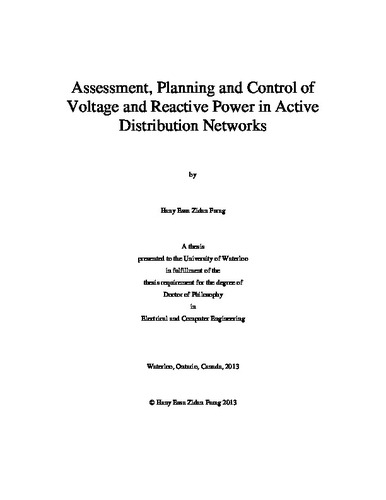| dc.description.abstract | Driven by economic, technical and environmental factors, the energy sector is currently undergoing a profound paradigm shift towards a smarter grid setup. Increased intake of Distributed and Renewable Generation (DG) units is one of the Smart Grid (SG) pillars that will lead to numerous advantages among which lower electricity losses, increased reliability and reduced greenhouse gas emissions are the most salient.
The increase of DG units’ penetration will cause changes to the characteristics of distribution networks from being passive with unidirectional power flow towards Active Distribution Networks (ADNs) with multi-direction power flow. However, such changes in the current distribution systems structure and design will halt the seamless DG integration due to various technical issues that may arise. Voltage and reactive power control is one of the most significant issues that limit increasing DG penetration into distribution systems. On the other hand, the term microgrid has been created to be the building block of ADNs. A microgrid should be able to operate in two modes of operation, grid-connected or islanded. The successful implementation of the microgrid concept demands a proper definition of the regulations governing its integration in distribution systems. In order to define such regulations, an accurate evaluation of the benefits that microgrids will bring to customers and utilities is needed. Therefore, there is a need for careful consideration of microgrids in the assessment, operation, planning and design aspects of ADNs. Moreover, SG offers new digital technologies to be combined with the existing utility grids to substantially improve the overall efficiency and reliability of the network. Advanced network monitoring, two ways communication acts and intelligent control methods represent the main features of SG. Thus it is required to properly apply these features to facilitate a seamless integration of DG units in ADNs considering microgrids.
Motivated by voltage and reactive power control issues in ADNs, the concept of microgrids, and SG technologies, three consequent stages are presented in this thesis. In the first stage, the issues of voltage and reactive power control in traditional distribution systems are addressed and assessed in order to shed the light on the potential conflicts that are expected with high DG penetration. A simple, yet efficient and generic three phase power flow algorithm is developed to facilitate the assessment. The results show that utility voltage and reactive power control devices can no longer use conventional control techniques and there is a necessity for the evolution of voltage and reactive power control from traditional to smart control schemes. Furthermore, a probabilistic approach for assessing the impacts of voltage and reactive power constraints on the probability of successful operation of islanded microgrids and its impacts on the anticipated improvement in the system and customer reliability indices is developed. The assessment approach takes into account: 1) the stochastic nature of DG units and loads variability, 2) the special philosophy of operation for islanded microgrids, 3) the different configurations of microgrids in ADNs, and 4) the microgrids dynamic stability. The results show that voltage and reactive power aspects cannot be excluded from the assessment of islanded microgrids successful operation.
The assessment studies described in the first stage should be followed by new voltage and reactive power planning approaches that take into account the characteristics of ADNs and the successful operation of islanded microgrids. Feeders shunt capacitors are the main reactive power sources in distribution networks that are typically planned to be located or reallocated in order to provide voltage support and reduce the energy losses. Thus, in the second stage, the problem of capacitor planning in distribution network has been reformulated to consider microgrids in islanded mode. The genetic algorithm technique (GA) is utilized to solve the new formulation. The simulation results show that the new formulation for the problem of capacitor planning will facilitate a successful implementation of ADNs considering islanded microgrids.
In the third stage, the SG technologies are applied to construct a two ways communication-based distributed control that has the capability to provide proper voltage and reactive power control in ADNs. The proposed control scheme is defined according to the concept of multiagent technology, where each voltage and reactive power control device or DG unit is considered as a control agent. An intelligent Belief-Desire-Intention (BDI) model is proposed for the interior structure of each control agent. The Foundation for Intelligent Physical Agents (FIPA) performatives are used as communication acts between the control agents. First, the distributed control scheme is applied for voltage regulation in distribution feeders at which load tap changer (LTC) or step voltage regulators are installed at the begging of the feeder. In this case, the proposed control aims to modify the local estimation of the line drop compensation circuit via communication. Second, the control scheme is modified to take into consideration the case of multiple feeders having a substation LTC and unbalanced load diversity. To verify the effectiveness and robustness of the proposed control structure, a multiagent simulation model is proposed. The simulation results show that distributed control structure has the capability to mitigate the interference between DG units and utility voltage and reactive power control devices. | en |

